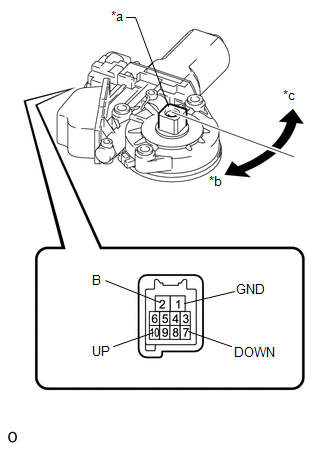Toyota 4Runner: Inspection
INSPECTION
PROCEDURE
1. INSPECT BACK DOOR POWER WINDOW REGULATOR MOTOR ASSEMBLY
|
(a) Check that the motor gear rotates smoothly as follows. NOTICE: Do not apply positive (+) battery voltage to any terminals except terminal 2 (B) to avoid damaging the pulse sensor inside the motor. OK:
CAUTION: Reset the power window regulator motor (initialize the pulse sensor) after installing the power window regulator motor and regulator assembly to the door. Text in Illustration
|
|
 Removal
Removal
REMOVAL
PROCEDURE
1. DISCONNECT CABLE FROM NEGATIVE BATTERY TERMINAL
CAUTION:
Wait at least 90 seconds after disconnecting the cable from the negative (-)
battery terminal to disable the SRS sys ...
 Installation
Installation
INSTALLATION
PROCEDURE
1. INSTALL BACK DOOR POWER WINDOW REGULATOR MOTOR ASSEMBLY
(a) Using a T25 "TORX" socket wrench, install the back power window regulator
motor assemb ...
Other materials about Toyota 4Runner:
Blower Motor Circuit
DESCRIPTION
The blower with fan motor sub-assembly operates according to signals from the
air conditioning amplifier assembly. The blower with fan motor sub-assembly speed
signals are transmitted by changes in the duty ratio.
Duty Ratio:
The duty rati ...
Brake Actuator (Skid Control ECU) Communication Stop Mode
DESCRIPTION
Detection Item
Symptom
Trouble Area
Brake Actuator (Skid Control ECU) Communication Stop Mode
Either condition is met:
"Skid Control (ABS/VSC/TRAC)" is not displa ...
0.0077

